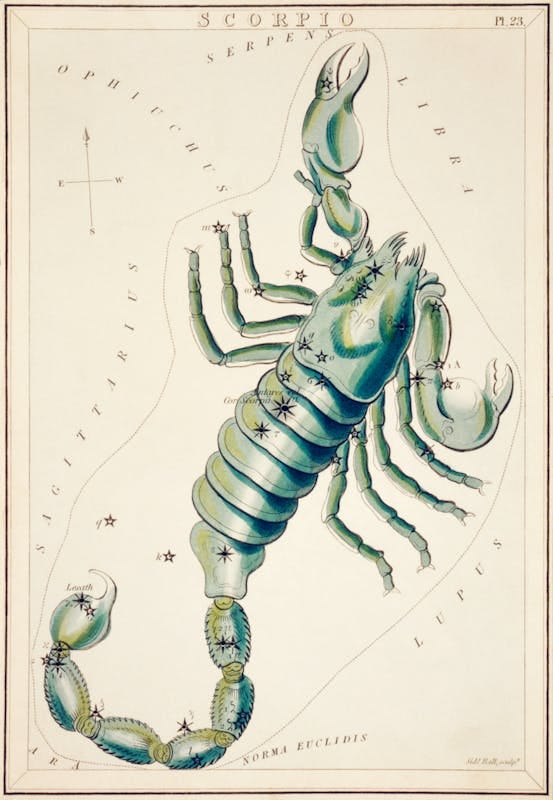The Underworld Stings: On Fixed Stars Acumen and Aculeus
Today’s newsletter is a deep dive on the fixed stars Acumen and Aculeus, found in the sting of the scorpion, or Scorpio, constellation. My favorite thing about that stars is that they speak in the language of myth, poetry, story. You don’t need to have much technical knowledge of astrology to appreciate the stars. We have been writing stories and praying to these nightly luminaries since we have been looking up at the sky. This essay is meant to help readers connect more deeply to these divine messengers and better understand ourselves. If you want to know if Acumen and Aculeus touch your chart, see if you have any planets or significant placements within 2º of 26º or 29º Sagittarius. Even if not, you have so much to learn from these fierce, clever stars.
If you want to learn more about how the stars touch and guide your beautiful life, and what your soul is asking of you, book a fixed star reading with me ⭐. You have to feel the magic of the stars yourself to believe it.
Facing the Battle
Acumen and Aculeus are two clusters of stars located in the stinging tail of Scorpius, the scorpion. They are seen as companion clusters, their meanings and myths highly intertwined. As befits their treacherous position in the scorpion’s body, these stars were primarily seen as malefic, offering battles and threats to those touched by their venom. Since Ancient Babylon, these stars have been a part of this deadly insect, the original constellation’s name, Gir-tab, meaning, ‘sharp weapon’ or ‘burning sting,” a reference, in particular to the lethal power of Acumen and Aculeus in the insect’s tail. The Acadians also called Scorpio Girtab, meaning “the seizer or “stinger” as well as the “Place where One Bows Down”, portending a danger that causes even the mightiest men to bend the knee and acknowledge the creature’s outsize might. How does one face battles that seem unwinnable or, when the battles outside seem futile, what victories can be found within? These are the questions these stars pose.
One would not expect such a threat from a tiny creature, but the recorded and mythic dangers of the scorpion are legion. Despite its diminutive size, the scorpion is quite the deadly foe, perhaps in part due to its sneaky, penetrating nature. Not only are scorpions nocturnal, they have long been associated with all manner of evils, from plagues, pestilence, infertility and the devil himself. According to Babylonian omenology, “‘If the Plough (Mars) comes close to the Scorpion: the ruler will die by the sting of a scorpion’”. Even the mightiest kings are no match for a stray scorpion sleeping in his boot.
We see this universally deadly aspect of the constellation echoed in the Greek myth connected to this asterism. Orion, one of the most skilled hunters and warriors in Ancient Greece, was pursuing the goddess Artemis with the intent of raping her. The huntress sends a scorpion to deter the hunter, who is handily killed by the creature. Though Zeus places Orion in the heavens as consolation, the Scorpion is placed right behind him, chasing the hunter through the sky for eternity. In the realm of the scorpion, the battle never ends. No matter how strong you are or how high you build your walls, these stars promise conflict, something to fear or to look over your shoulder to avoid. Sometimes, the foes are external, but like the venom of the scorpion, penetrating you from within, much of the war is fought within oneself, regardless of outside threats.
“Natures Ardent for War”
Manilius, mirroring this sentiment, writes that “the Scorpion creates natures ardent for war and active service, and a spirit which rejoices in plenteous bloodshed and in carnage more than in plunder”. He tells us that “these men spend even peace under arms” and devote their studies to the art of war. Though all of the Scorpio constellation is known for its prowess in fighting and piercing victory, we see this theme of attack no more than in Acumen and Aculeus. Even when there are no battles to face, these stars find one, often facing their own demons and traversing their own underworlds to rejoice in carnage. These are not stars you call upon to accumulate resources or gain something, but to exorcise or root something out, letting something new transform in its place.
As the stars of the stinger, those touched by these stars must face conflict in all realms, both external and internal battlefields. Diana Rosenberg sees this bellicose nature in a tendency to judge oneself too harshly: “Some, feeling burdened by criticism, ostracism or constant demands, may lash out with the Scorpion's stinging poison, or sink into themselves, hearing only their own voice and will”. Always looking for potential threats or chinks in the armor can lead to turning the threat monitoring inward, leading those touched by these stars to be overly judgmental or exacting with their own self-standards. Here we see the war during peacetime come about: there may be a difficulty with ease or letting one’s guard down because these stars make one so attuned to potential threats. Though perfect to hone your inner rebel or sety our own standards in a hostile world, it is not the best when you wants to relax or trust others.
The Talking Weapon
But in times of war, no one is as effective as these two star clusters. According to Babylonian mythology, the Stinger represented the battle-mace of the the warrior god Ninurta. But despite his aggressive nature, Ninurta was also known as a healing, protective deity who was drawn down in magical rituals to protect the practitioner from all forms of harm. Similarly, these stars can also be used for apotropaic purposes, helping create a ruthless defense from all manner of physical and spiritual attacks, bringing healing by first removing what is hindering it.
Keep reading with a 7-day free trial
Subscribe to Recent Bedroom to keep reading this post and get 7 days of free access to the full post archives.





